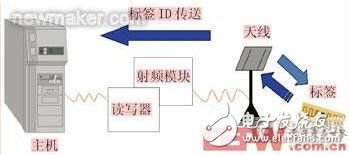At present, the degree of informatization in the automotive industry is mixed, some of them are highly informatized, and some still use the method of completely manual operation. Although most enterprises have established their own ERP systems, most of them have different information systems, serious information islands, and inconsistent informationization. All companies hope to establish a recognition system to improve their management level, improve the efficiency of the entire logistics process, and reduce the error rate.
System architecture and principlesThe construction of the local area network of the RFID automobile industrial application system is to connect all intelligent handheld terminals to the local area network through a wireless AP (Access Point, wireless access node), and connect to the back-end database. The front desk uses fixed and handheld RFID readers, RFID printers (for printing RFID tags), printers (for printing out, inbound orders), APs, and connection back-end databases.
A typical RFID automatic identification system consists of the following parts: Tag, Reader, Antenna, ApplicaTIon System, etc. The working principle is shown in Figure 1.

Figure 1 RFID automatic identification system composition
Establish a unified central database on the enterprise workshop site as an information platform for the circulation of goods, so as to facilitate the overall standard management. In the industrial sector, RFID technology is used to assign an identification number (ID, which is the name of the component in the information network) to each component in the product. Through the RFID technology, the production status and inventory status are mapped to the information network, and registered at the site. In the central database, it is transmitted to the information system (such as ERP, MRP, etc.).
System moduleThe RFID automotive industry application system mainly includes the following functional modules: user login and signal testing (including network settings), traceable parts scanning, consolidation, reading, kanban card and pull single association, repacking plan download, inventory, domestic Large-size standard packaging out of the warehouse, original packaging quantity modification, reworked parts storage, standard large-size packaging out of the warehouse, original packaging out of the warehouse, reworked parts out of the warehouse, standard small parts packaging out of the warehouse, the original packaging on the line, the standard packaging on the supermarket material Frame, unplanned picking, original packaging quantity input, standard packaging quantity modification, standard packaging offline, original packaging remaining quantity confirmation, notice download, original packaging in LCL, password modification, part information inquiry, etc.
RFID system use benefits1. Error prevention management
Nowadays, user customization has become popular. Users can choose the color, engine model and tire style of the required car from tens of thousands of internal and external options. As a result, hundreds of kinds of assembly lines must be assembled on the assembly line. A model car is difficult to accomplish such a complex task without a highly organized, complex control system. Equipped with an RFID system on the assembly line, using a reusable RF tag with all the requirements for a detailed car, with readers at each point of operation, so that the car is guaranteed Assembly tasks can be completed without errors at each pipeline location.
2. Warehouse management (as shown in Figure 2)


Figure 2 Warehouse Management
Use the RFID system to create a complete supplier delivery quality record and batch information, and record the parts supplied by each supplier (based on the electronic signage into the enterprise) to know its model, type, batch, date of manufacture Wait for the warehousing and delivery management.
3. Real-time monitoring of the production line (as shown in Figure 3)


It can carry out RFID tracking management for the whole production process of the product entering the assembly shop to the final inspection of the whole vehicle.
4. Cost control
Using modern logistics theory to improve auto parts and vehicle warehousing can save costs and save production and temporary inventory waste in various workshops.
5. Product traceability
In recent years, China has introduced a car recall system, which puts higher requirements on product traceability. Product traceability requires detailed production site records, including production, quality, and materials.
According to the RFID tag information, the manufacturing information of the car at each key station of the assembly shop can be found in real time, such as production time, operator, inspector, batch, serial number, quality data, process data, test data, etc. Manufacturing process information, such as repair and processing results; can query the quality information of the car at important stations, including defect data, measurement data and process capability of the station; can trace the important parts and safety parts of the car Relevant information such as quality information, manufacturer information of major components, and specific details of installation.
Based on product information, it can be traced back to product batches and key component batches to find other products in the same batch; up to traceable to materials and components, down to end users.
6. Defect management
The whole vehicle production is mainly assembly, involving a large number of components (including in-house self-made parts and external parts). In the assembly process, various defects are inevitable, and there are parts from the parts, which are produced in this process, and also in the process. of. In order to improve the quality and reduce the repair rate, it is necessary to monitor and record the defects of each vehicle in real time and take timely measures.
RFID system advantages1. The electronic tag can be read multiple times (up to 100,000 times);
2. The RFID electronic tag can be read stably by the reader (low error rate);
3. Can save a lot of manpower and time;
4. The main system's command of the production process is comprehensively improved;
5. Integrate the whole process of production and the main system, and the production efficiency is greatly improved.
Type1 To Type2 EV Charging Cable
Type1 To Type2 Ev Charging Cable,Type 1 To Type 2 Charging Cable,Type 1 And Type 2 Ev Charging,Type 1 To Type 2 Cable
Yangzhou JERI New Energy Co., Ltd. , https://www.jrevcharging.com